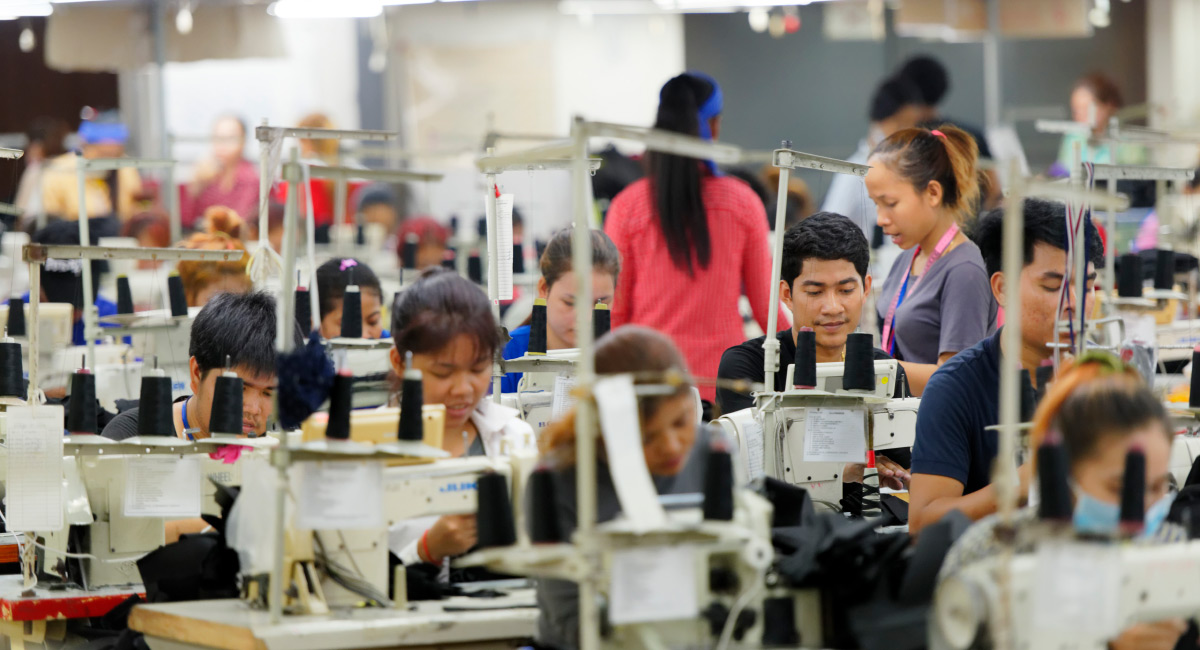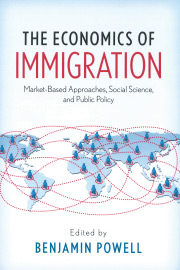Abstract
Many studies have shown that multinational firms pay more than domestic firms in Third World countries. Economists critical of sweatshops have responded that multinational firms’ wage data do not address whether sweatshop jobs are above average because many of these jobs are with domestic subcontractors. In this paper we compare apparel industry wages and the wages of individual firms accused of being sweatshops to measures of the standard of living in Third World economies. We find that most sweatshop jobs provide an above average standard of living for their workers.
Over the past decade U.S. firms and their subcontractors have faced protests from student groups, labor leaders, and some government officials for employing sweatshop labor. Sweatshops are generally characterized as places of employment that have low pay, poor working conditions, and long hours. Most economists view so-called sweatshops as a benefit to Third World workers and recognize that the anti-sweatshop activists’ activities could reduce Third World employment and investment, thus making workers worse off. In response to the anti-sweatshop movement, economists in the Academic Consortium on International Trade (ACIT), led by Jagdish Bhagwati, circulated a letter to colleges and universities urging them to become aware of the downsides to anti-sweatshop movement demands before adopting any policies.
The economic way of thinking views sweatshops from an exchange perspective in which both workers and employers gain when they voluntarily enter into a labor contract—no matter how low the wages may seem to external observers. From Walter Williams (2004) on the right to Paul Krugman (1997) on the left, economists across the political spectrum have defended sweatshops in the popular press.[1] One economist critical of sweatshops even observed that most economists’ opinion is “as simple as this: ‘Either you believe labor demand curves are downward sloping, or you don’t,’ as a neoclassical colleague said to me. Of course, not to believe that demand curves are negatively sloped would be tantamount to declaring yourself an economic illiterate” (Miller 2003).
Not all economists support sweatshops, however. In response to the letter circulated by ACIT, a group calling themselves Scholars Against Sweatshop Labor (SASL) circulated their own letter in support of the student anti-sweatshop movement.
The letter had 434 signatories, 73 percent of whom were economists. At least one scholarly article by an economist, (Miller 2003) “Why Economists are Wrong About Sweatshops,” has criticized the mainstream economic view of sweatshops.
Much of the scholarly work on sweatshops has been performed by non-economists or has limited itself to documenting the organization and activities of the anti-sweatshop movement. Examples include Mandle (2000), Appelbaum and Dreier (1999), and Firoz and Ammaturo (2002). Only a few economic papers have dealt directly with sweatshops. Brown, Deardorff, and Stern (2003) modeled the theoretic frameworks in which multinational firms could raise or lower wages. Elliot and Freeman (2001) outlined the most harmful of the anti-sweatshop activists’ demands. Moran (2002 Ch. 1 and 2) documents that foreign direct investment and the firms it encourages provide above average pay and benefits for Third World workers.
Most scholarly work by economists related to sweatshops has focused on the wages multinational firms pay. Several econometric studies demonstrate the benefits multinational firms provide. Aitken, Harrison, and Lipsey (1996) and Lipsey and Sjoholm (2001) both find that after controlling for other factors, multinational firms pay higher wages than domestic firms in Third World countries. Feenstra and Hanson (1997) find that multinational firms improve the lives of workers by increasing the demand for labor. Budd and Slaughter (2000) and Budd, Konings, and Slaughter (2001) find that as multinational profits go up, multinational firms share gains with Third World workers. Brown, Deardorff and Stern (2003) summarize the literature documenting the benefits multinational companies provide to Third World workers.
Economists critical of sweatshops usually do not dispute that multinational firms pay more than domestic firms in most cases. Miller (2003) notes,
The ACIT writes that multinational corporations “commonly pay their workers more on average in comparison to the prevailing market wage for similar workers employed elsewhere in the economy.” But, as the SASL authors correctly point out, “While this is true, it does not speak to the situation in which most garments are produced throughout the world—which is by firms subcontracted by multinational corporations, not the MNCs themselves (p.101).
This paper expands on the existing literature by comparing sweatshop wages, without regard to whether a firm is multinational or a domestic subcontractor of such, to standards of living in the countries in which they employ workers. We compiled a list of countries where U.S. news sources have reported sweatshops. The apparel industry is widely cited in the press for using sweatshops most frequently, so apparel industry wages in these countries are compared to average income, average wages and poverty earnings, in the next section of this paper. In the third section we compare the wages at individual firms accused of being sweatshops with these same standard of living measures. Apparel Jobs Compared to Average Living Standards
The apparel industry has drawn the most attention the press for its use of sweatshop labor. Sometimes a U.S. firm directly employs Third World workers, but more often subcontractors actually produce the products. Table 1 contains the average apparel industry wages in countries where sweatshops supposedly exist.[2]
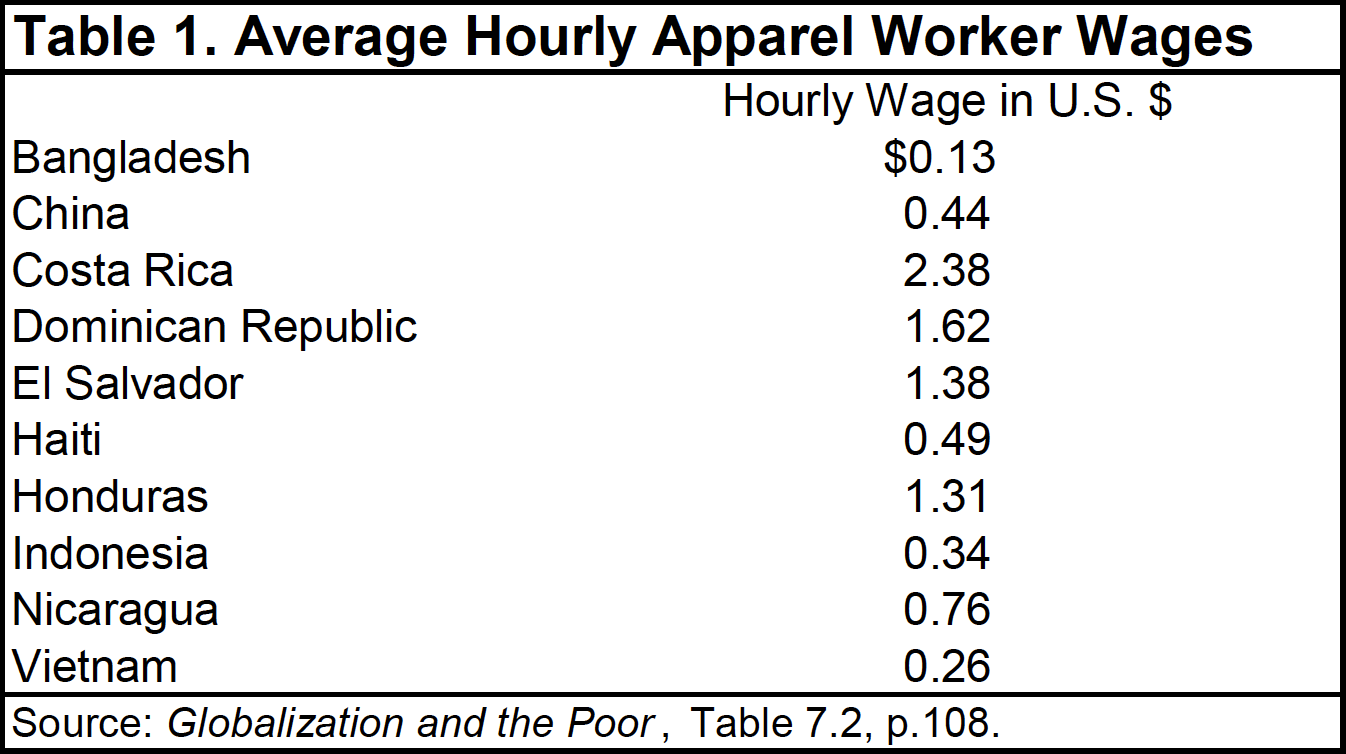
Apparel industry wages are low by U.S. standards, but they compare favorably with the average standard of living in these countries. Figure 1 shows the average apparel worker’s earnings as a percent of average per capita income. Since no data documenting the average number of hours worked in the apparel industry were available, we provide four estimates that vary the hours worked per week between 40 and 70. The 60 and 70 hour estimates are more likely to be accurate since these employees often work long hours and six days per week.
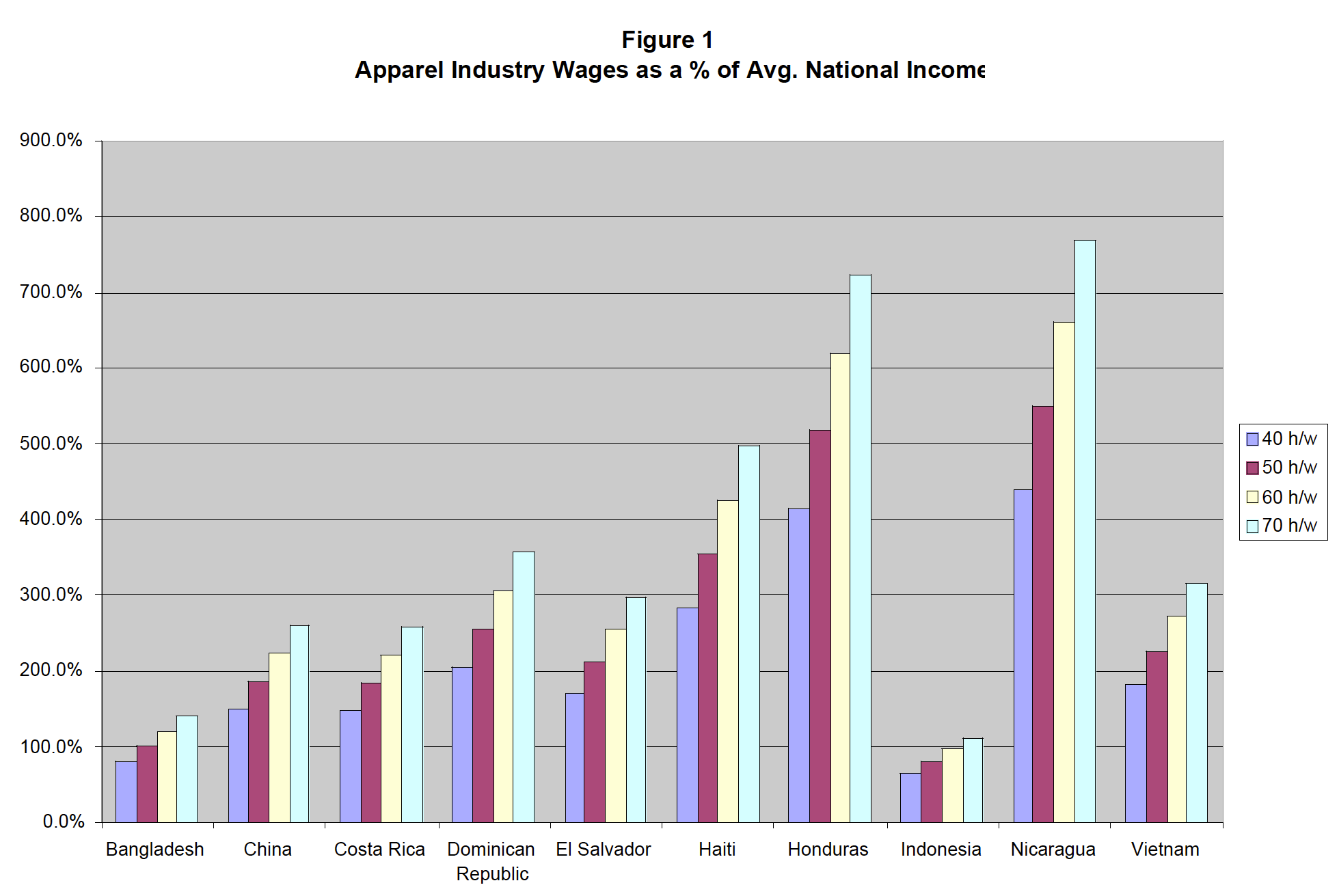
Figure 1 shows that if working 70 hours per week, apparel workers’ average income exceeds the average income in each country.[3] In 9 of 10 nations, average apparel industry income exceeds the national average at only 50 hours per week. Apparel workers in the Dominican Republic, Haiti, Honduras, and Nicaragua earn 3 to 7 times the national average.
National income per capita divides the total output of the economy by the total population, both workers and non-workers. If apparel industry workers tend to be young and without a family, or women and children, then comparing apparel wages to average income per capita gives a fairly accurate assessment of how they live compared to others in their economy since their income is only supporting one person. Women and children were often the workers in 19th century U.S. and British sweatshops, and some anecdotal evidence from the Third World suggests this may be true there too.
It is also useful to compare apparel industry workers’ earnings to just other workers’ wages. Unfortunately, good wage data does not exist. To approximate average wage data, we have used employment participation data to adjust average income per capita to reflect average income per worker. Data on labor force size do not count workers in the informal sector, which can be quite large in these countries, but the value of what informal workers produce is often estimated in GDP measures.[4] Accordingly, our measure of earnings per worker likely overstates average income per worker and thus causes us to understate apparel industry wages as a percent of average income per worker.
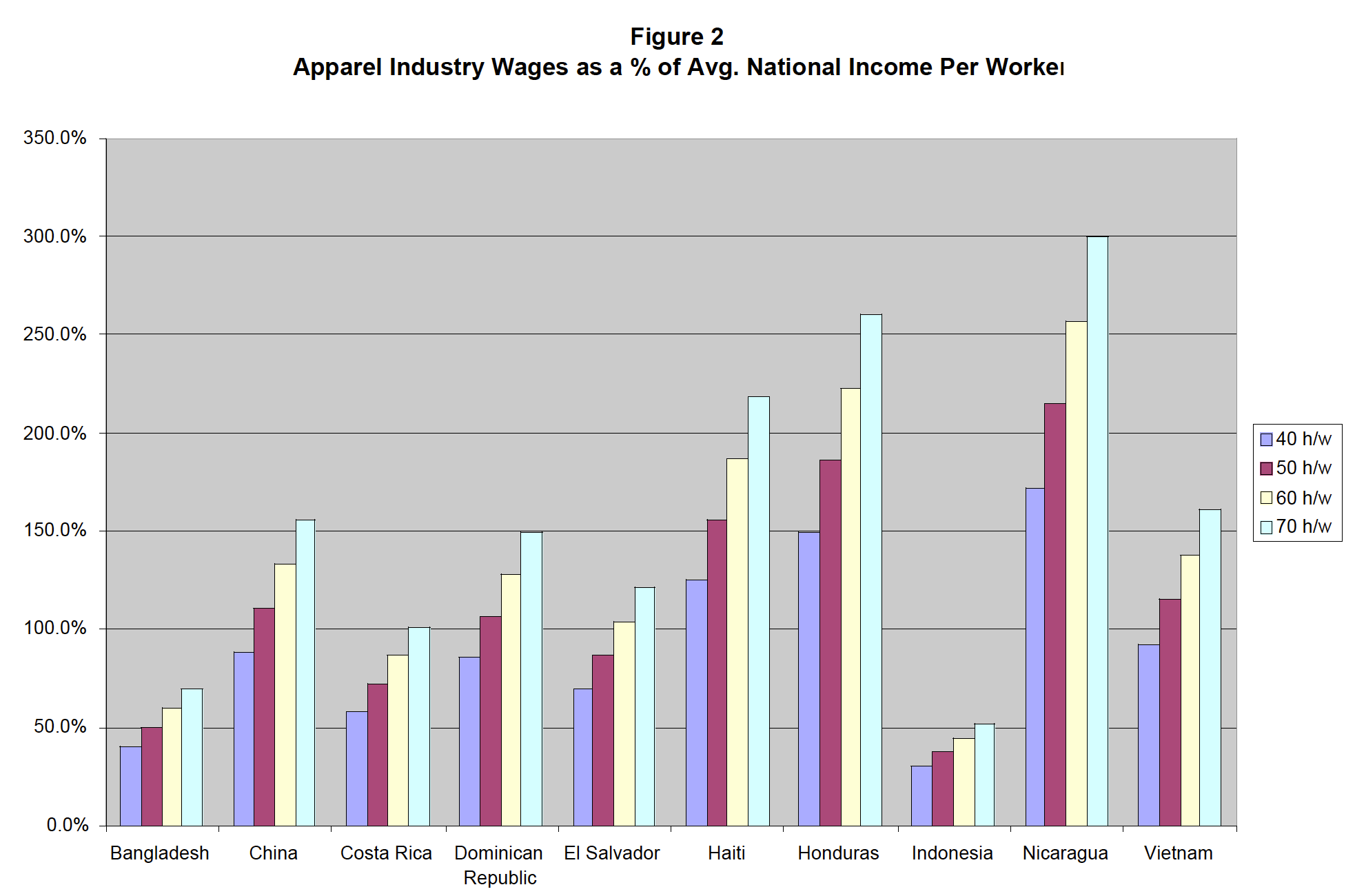
Figure 2 shows that despite this bias, average apparel industry wages equal or exceed average income per worker in 8 of 10 countries. At 70 hours of work per week, apparel worker earnings in six countries exceed 150 percent of average income per worker, and they more than double the average in three countries.
We can also compare apparel industry earnings to the dire poverty in these countries. Table 2 reports the World Bank’s estimated percent of the population that lives on less than $1 and $2 per day. In most of these countries more than half the population lives on less than $2 per day. Yet, in 9 of 10 countries, working 10 hour days in the apparel industry lifts employees above (and often far above) the $2 per day threshold. Even in the one exception, Bangladesh, working 10 hour days in the apparel industry results in earning more than the 36% of the population living on less than $1 per day.
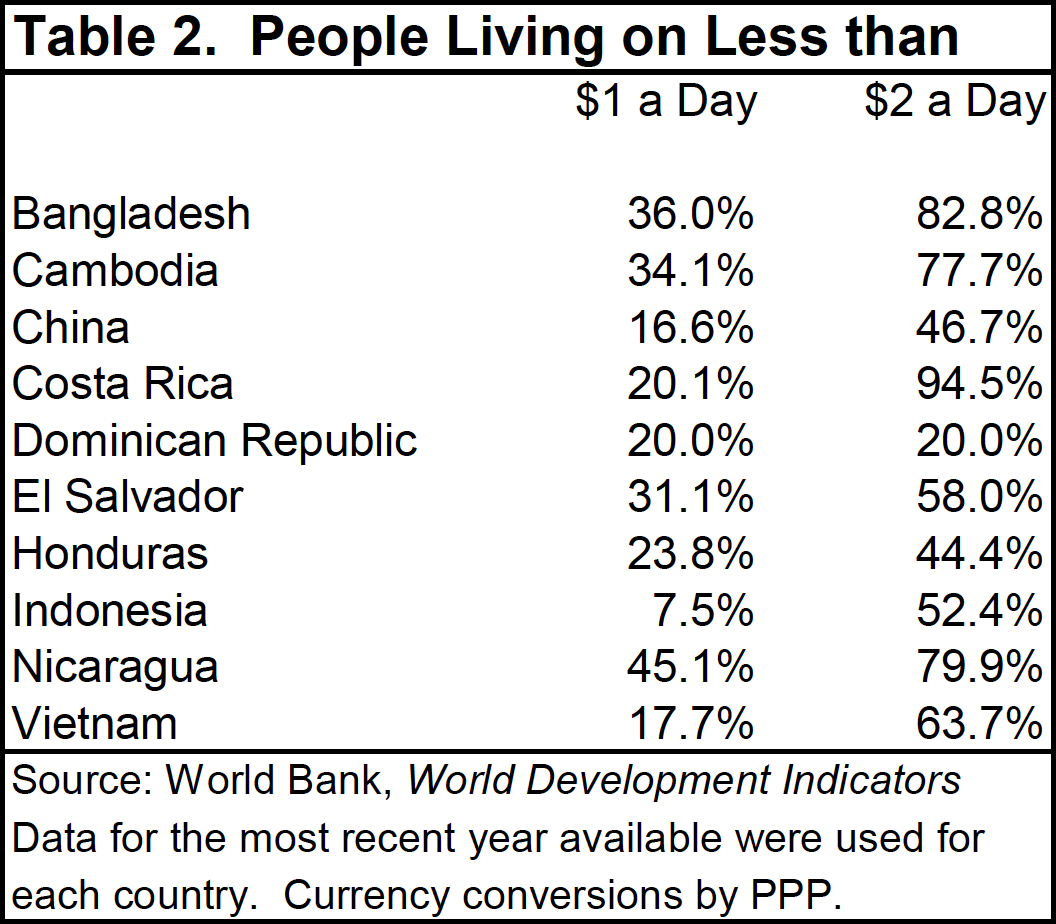
The apparel industry has been widely criticized for “exploiting” Third World workers in sweatshops, but the data show that these workers are better off than most people in their countries. Although the apparel industry as a whole pays better, anti-sweatshop activists sometimes single out particular firms as exploitative. We next look at examples in which specific firms have been protested for being sweatshops. Wages in Sweatshop Firms Compared to Living Standards
Our data come from popular press articles that document sweatshop wages.[5] Many of the wages quoted come directly from anti-sweatshop activists. Thus, any bias would understate the actual level of compensation.[6] Despite this, we find that when compared to per capita income in these countries, most sweatshops pay more than the average standard of living.
Table 3 lists the wages that sweatshop workers reportedly earn and, when available, the company involved. These wages are obviously quite low compared to those in the U.S., but a high percentage of people in these countries earn less than $1 or $2 per day. In 41 of 43 cases, working 10 hour days results in earning more than $1 per day, and in more than half the earnings are greater than $2 per day. Sweatshop wages raise workers’ standard of living higher than a significant fraction of the population.
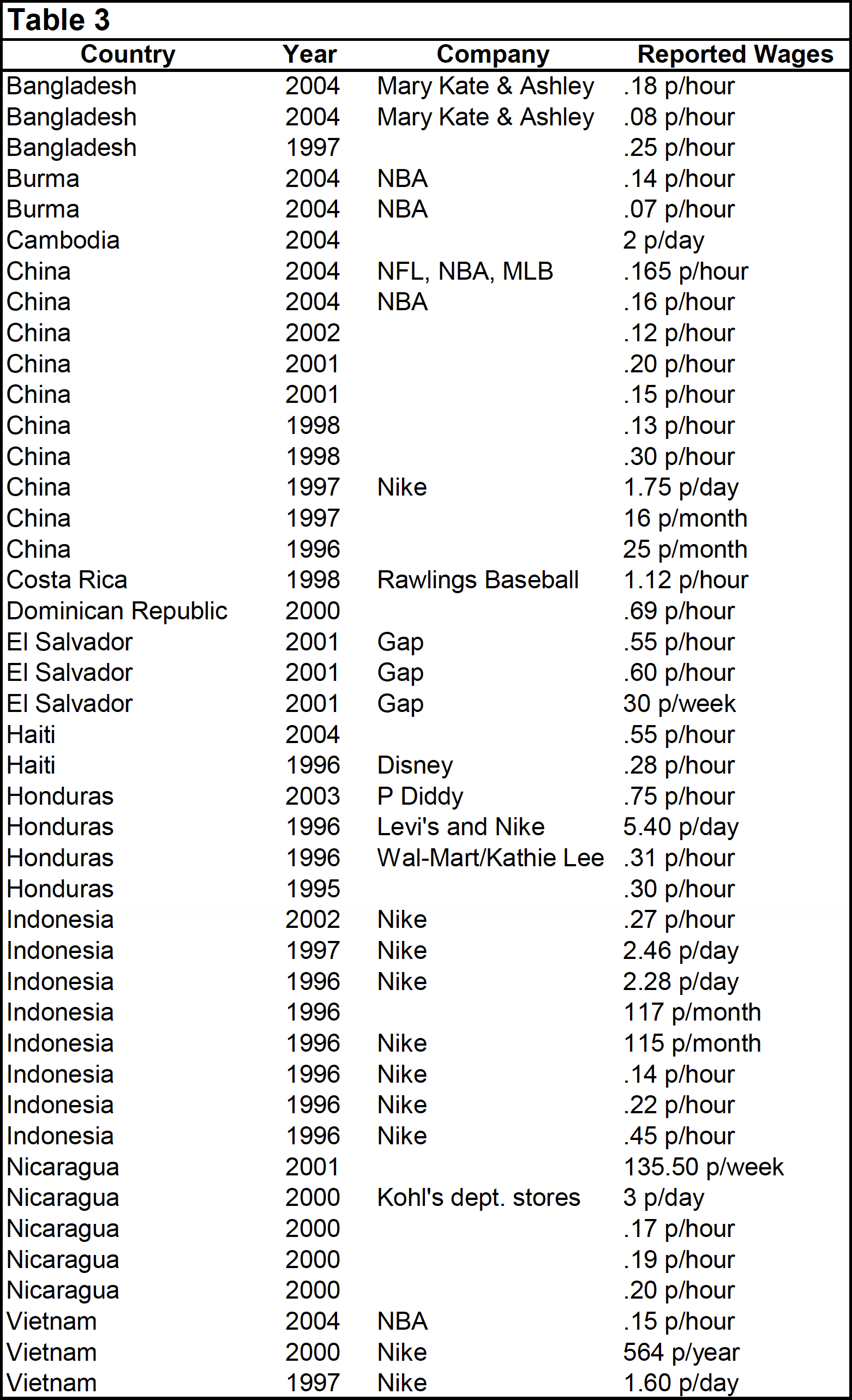
Figure 3 shows average reported sweatshop wages as a percent of each country’s average income.[7] Since many news articles contained hourly wage data without stating the number of hours worked, we again created four estimates that vary hours worked per week between 40 and 70. When articles reported daily wage data, we based our calculation on six days of work per week. The 40 hour estimate is probably low again since most sweatshop employees work long hours and often work six days per week. When articles provided estimated hours of work, most were in excess of 70 per week; we included the actual hours in the 70 hour estimate when they were available.
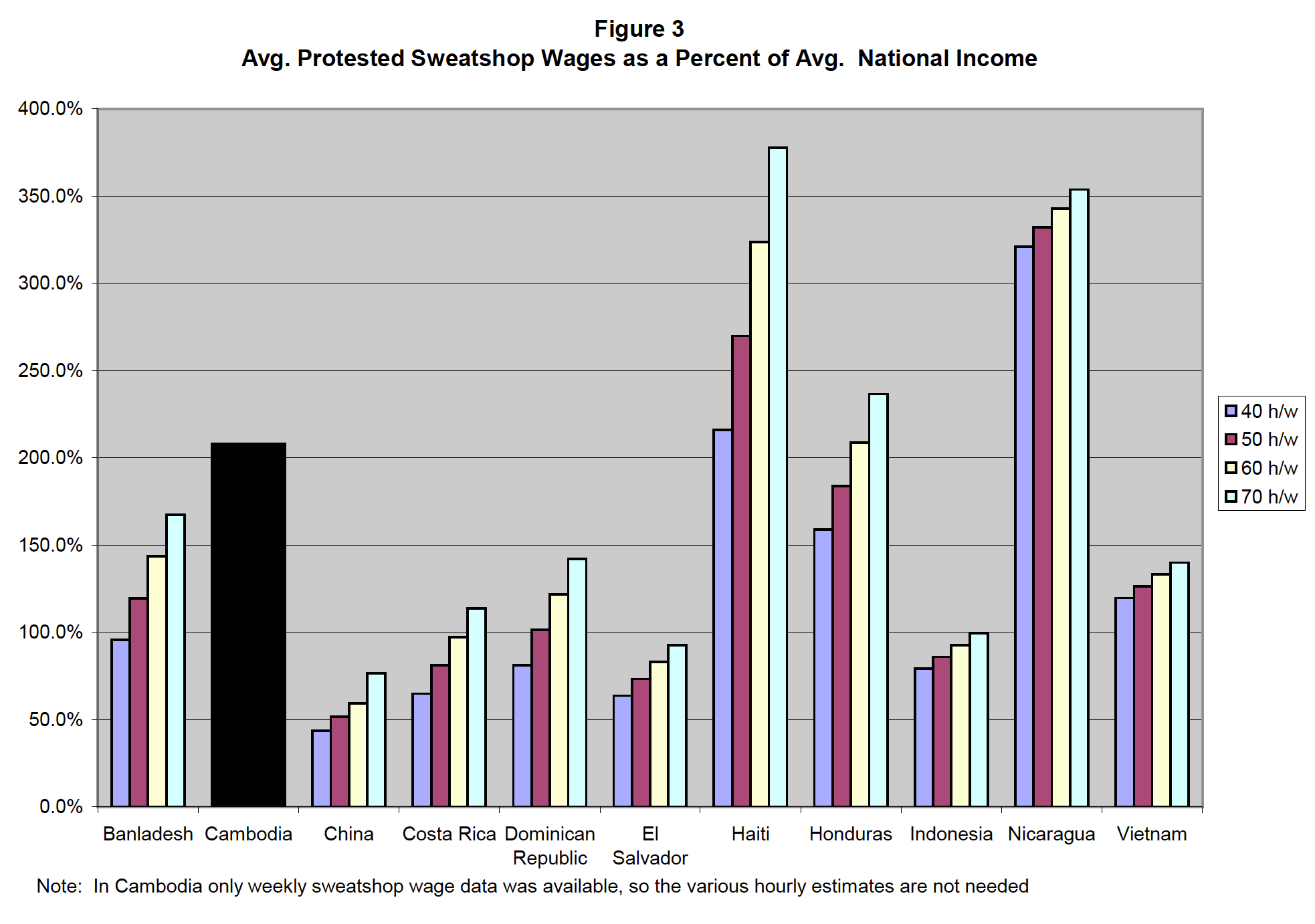
In 9 of 11 countries, the reported sweatshop wages equal or exceed average income, doubling it in Cambodia, Haiti, Nicaragua, and Honduras (at 70 hours). However, these figures do not include non-monetary compensation. Nike’s employees in Indonesia, for example, receive free health care and meals in addition to their wages (Jones 1996). Since 7 of 8 Indonesian examples alleged Nike factories to be sweatshops, not including non-monetary compensation causes our Indonesian sweatshop wage estimates to appear far lower than they should. If firms in other countries also provide additional benefits, their wages may be similarly understated. Overall, even with our data limitations, Figure 3 demonstrates that most of the jobs that some anti-sweatshop advocates protest raise their workers’ standard of living above their nation’s average.
The above figure compares sweatshop wages with average income for both workers and non-workers. We can again make the adjustment, with the same data limitations as before, to compare protested sweatshop jobs with average income per worker. Due to not counting the large informal sector, we are again likely understating sweatshop earnings as a percent of average earnings per worker. The bias that our data often come directly from those with the most incentive to understate earnings also remains.
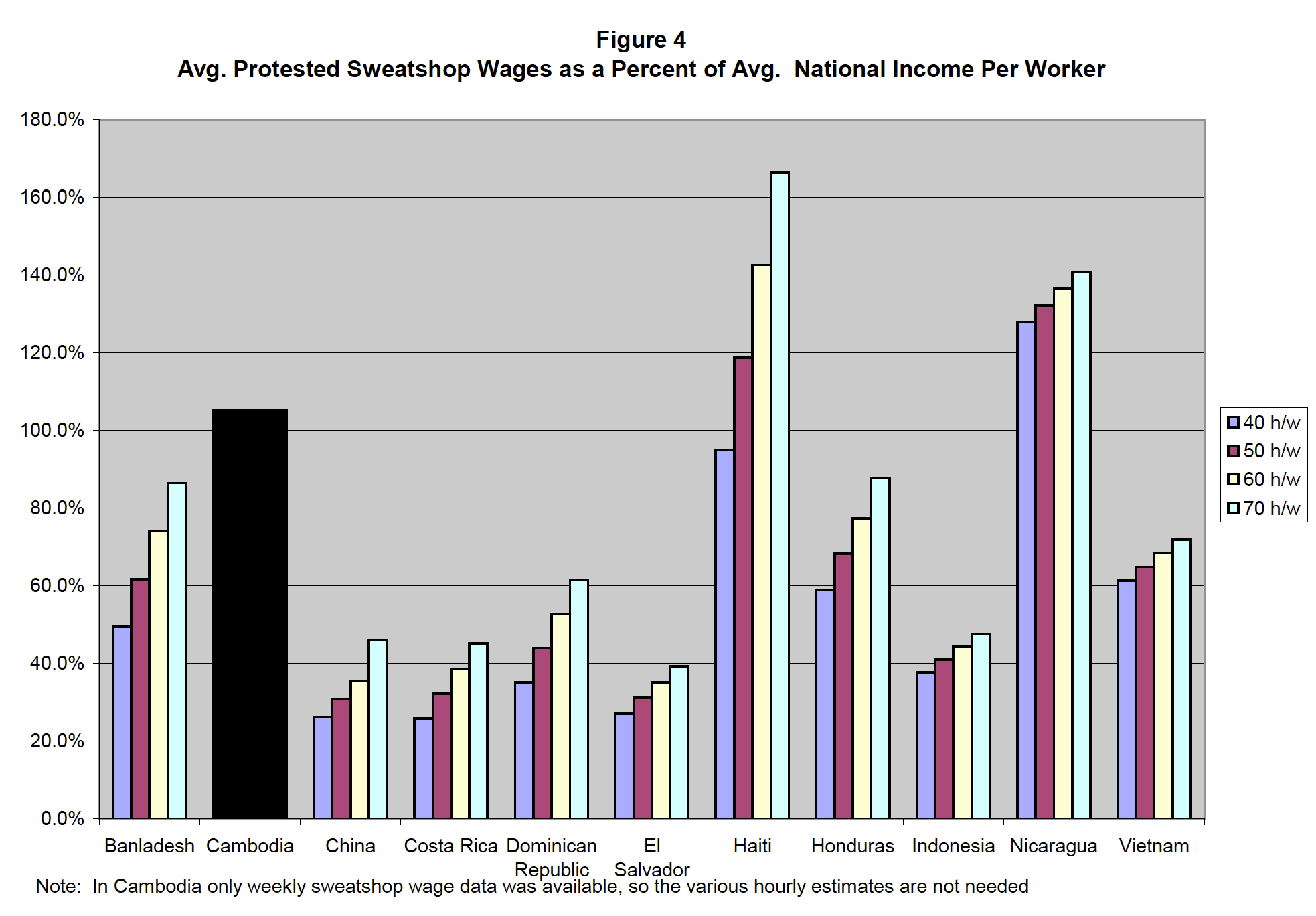
Figure 4 shows that the average protested sweatshop worker earns more than the average worker in Cambodia, Haiti and Nicaragua. In most countries the protested wages are more than 60 percent of the average. It is important to remember the biases and limitations of this data when comparing these numbers.
In addition, the relevant comparison facing an individual worker is not average wages but individual alternatives. Sweatshops make a worker better off when they pay more than that specific worker’s next best alternative. Thus, even where earnings are less than 100 percent of average wages, as long as workers voluntarily choose to work at the sweatshop, it makes the individual worker better off.
Some caution should be used when looking at the data for China. A few articles reported that the Chinese government "forced" people to work in sweatshops. If this is true, then we cannot assume that the jobs make the workers better off. Since the extent to which the Chinese examples were voluntary or coerced was unclear, we averaged them all. As such, coerced labor may be causing their reported wages to be a lower percent of average income than other countries.
Conclusion
Few dispute that multinational firms tend to pay their workers more than domestic firms in the Third World. Critics of sweatshops maintain that because subcontractors make many products for multinational firms, measuring only multinational firm wages does not address critics’ complaints against sweatshops. We have addressed the deficiency in the literature by comparing apparel industry wages in countries that supposedly have sweatshops and the wages of individual firms accused of being sweatshops to measures of average standards of living in these countries. The data clearly show that overall, apparel industry workers are far better off than most people in their economies. However, while the best available, the data used was far from perfect. Biases are likely causing us to understate earnings as a percent of living standards. Despite data limitations, individual firms accused of paying sweatshop wages often still compare favorably with other standard of living measures.
Notes
[1]Other excellent examples include Sowell (2004) and Henderson (2000).
[2] Countries where at least one U.S. news source claimed sweatshops existed were included.
[3] All data on average per capita income and labor force size used in Figures 1-4 come from the World Bank’s World Development Indicators Online, accessed July 2004. Conversions of per capita income from local currency to U.S. currency are made by the World Bank using the atlas method.
[4] The common perception is that “everybody works” in these countries, yet because much of the work is in agriculture or the informal sector, many workers are not counted in the official labor force participation numbers used here.
[5] Branigin (1998), Eversley (2000), Foster (2001), Greenhouse (1996), Greenhouse (2001), Grow (2000), Hayden and Kernaghan (2002), Hiam-White (1998), Holstrom (1996), Jones (1996), Kaufman and Gonzalez (2001), Kennel (1996), Mallick (1997), Meyer (1997), National Labor Committee (2004), O’Connor (1995), Pabst (2000), Sneider (2000), Stelzer (1996), St. Petersburg Times (1996), Tracinski (2000), Washington Post (2002), Wells (2004), Williams (2004).
[6] Each article converted domestic wages into U.S. prices without mentioning the exchange rate method used for conversion. Two articles may quote different wages when referring to the same case because of different methods of conversion. When we identified multiple articles referring to the same case, we included the individual sweatshop only once in our sample.
[7] We compared each reported sweatshop wage with the average income in the year for which the wage was reported. To compare average sweatshop earnings to average income for a country without biasing the results, we also averaged the per capita income data for each observation. For example, if a country had two reported sweatshop cases in 1996, one in 1997 and one in 2000, we averaged those wages and compared to [(GNI 1996)+(GNI 1996)+(GNI 1997)+(GNI 2000)] / 4
References
Academic Consortium on International Trade (2000)
Appelbaum, Richard and Dreier, Peter (1999) “The Campus Anti-Sweatshop Movement.” The American Prospect. No. 46, Sept/Oct, pp.71-78.
Aitken, Brian, Harrison, Ann, and Lipsey, Robert (1996) “Wages and Foreign Ownership: A Comparative Study of Mexico, Venezuela, and the United States.” Journal of International Economics. Vol. 40, pp. 345-371.
Branigin, William (1998) “Chinese Sweatshops Labor for U.S. Retailers.” The Washington Post. March 19.
Brown, Drusilla, Deardorff, Alan, and Stern, Robert (2003) “The Effects of Multinational Production on Wages and Working Conditions in Developing Countries.” NBER Working Paper 9669. Cambridge: National Bureau of Economic Research.
Budd, John, Konings, Jozef, and Slaughter, Matthew (2002) “International Rent Sharing in Multinational Firms.” NBER Working Paper 8809. Cambridge: National Bureau of Economic Research.
Budd, John and Slaughter, Matthew (2000) “Are Profits Shared Across Borders? Evidence on International Rent Sharing.” NBER Working Paper 8014. Cambridge: National Bureau of Economic Research.
Elliott, Kimberly and Freeman, Richard (2001) “White hats or Don Quixotes? Human Rights Vigilantes in the Global Economy.” NBER Working Paper 8102. Cambridge: National Bureau of Economic Research.
Eversley, Melanie (2000) “McKinney says military buys from sweatshop.” The Atlanta Journal and Constitution. December 6.
Feenstra, Robert and Hanson, Gordon (1997) “Foreign Direct Investment and Relative Wages: Evidence from Mexico’s Maquiladoras.” Journal of International Economics. Vol 42, pp. 371-393.
Firoz, Nadeem and Ammaturo, Caren (2002) “Sweatshop Labour Practices: The Bottom Line to Bring Change to the New Millennium Case of the Apparel Industry.” Humanomics, Vol. 18, No.1-2, pp.29-45.
Foster (2001) “No sweatshops, please.” Milwaukee Journal Sentinel. January 7.
Greenhouse, David (1996) “A Crusader Makes Celebrities Tremble.” The New York Times. June 18.
Greenhouse, Steve (2001) “Big-League Caps and Labor Flaps.” The New York Times. August 21.
Grow, Doug (2000) “Sweatshop opponents keep up the pressure on Kohl’s; Members of St. Thomas the Apostle add their voices with Christmas messages to executives.” Star Tribune. December 25.
Hayden, Tom and Kernaghan, Charles (2002) “Pennies an Hour, and No Way Up.” The New York Times. July 16.
Hiam-White, Hether (1998) “A Look at...Manufacturing Christmas: Their Labor, Our Gifts, Your Choices.” The Washington Post. December 20.
Henderson, David (1997) “The Case for Sweatshops.” The Weekly Standard. February 7. Available: www-hoover.stanford.edu/pubaffairs/we/current/Henderson_200.html
Holmstrom, David (1996) “One Man’s Fight Against Sweatshops.” Christian Science Monitor. July 3.
Jones, Del (1996) “Critics tie sweatshop sneakers to ‘Air’ Jordan” USA Today. June 6.
Kaufman, Leslie and David Gonzalez (2001) “Made in Squalor: Reform has limits.” The New York Times. April 24.
Kennel, Paul (1996) “The Sweatshop Dilemma.” Christian Science Monitor. August 21.
Krugman, Paul (1997) “In Praise of Cheap Labor, Bad Jobs at Bad Wages are Better Than No Jobs at All.” Slate. March 20.
Lipsey, Robert and Sjoholm, Fredrik (2001) “Foreign Direct Investment and Wages in Indonesian Manufacturing.” NBER Working Paper 8299. Cambridge: National Bureau of Economic Research.
Mallick, Heather (1997) “Stop the World I Want to Get Off.” The Toronto Sun. January 26.
Mandle, Jay (2000) “The Student Anti-sweatshop Movement: Limits and Potential.” Annals of the American Academy of Political and Social Science. Vol. 570, pp. 92-103.
Meyer, Tara (1997) “No widespread abuse at Nike’s Asian Plants.” Chicago Sun-Times. June 25.
Miller, John (2003) “Why Economists Are Wrong About Sweatshops and the
Antisweatshop Movement.” Challenge. Vol. 46, No. 1, pp. 93-122.
Moran, Theodore (2002) Beyond Sweatshops. Washington, DC.: Brookings Institution Press.
National Labor Committee (2004) “Sean John’s Sweatshops.” May 28. http://www.nlcnet.org/campaigns/setisa/.
National Labor Committee (2004) “Toys of Misery 2004.” May 28. http://www.nlcnet.org/campaigns/he-yi/.
National Labor Committee (2004) “Baseball Workers Cry Foul.” May 28. http://www.nlcnet.org
National Labor Committee (2004) “Bangladeshi Workers Deserve Maternity Rights.” May 28. http://www.nlcnet.org/.
National Labor Committee (2004) “Why Is the NBA Exploiting 7-cent-an-hour & Slave Labor, And Supporting Brutal Military Dictators and Drug Lords in Burma?” May 28. http://www.nlcnet.org/campaigns/nba/.
O’Connor, Anne-Marie (1995) “The Plight of Women Around the World; Central
America; Labor: Sweatshops meet U.S. consumer demand.” The Atlanta Journal and Constitution. September 3.
Pabst, Georgia (2000) “Nicaragua union leader seeks support for garment workers.” Milwaukee Journal Sentinel. June 20.
Scholars Against Sweatshop Labor (2001) http://www.umass.edu/epri/sasl/petition.htm
Sneider, Jaime (2000) “Good Propaganda, Bad Economics.” The New York Times. May
16. Sowell, Thomas (2004) “Third World Sweatshops: Why Cambodian Workers Bribe for
‘Sweatshop’ Jobs.” Capitalism Magazine. January 27.
Stelzer, Irwin (1996) “Sweatshops put heat on bosses.” Sunday Times. July 28.
St. Petersburg Times (1996) “Celebrities should endorse products made in America.”
June 13. Tracinski, Robert (2000) “Sweatshops or opportunity for the Third World’s poor?” The San Diego Union-Tribune. June 1. Washington Post (2002) “For Some, an Uncomfortable Fit.” May 14.
Wells, Jennifer (2004) “T-shirt maker struggles with sweatshop visuals.” The Toronto Star. February 29.
Williams, Walter (2004) “Sweatshop Exploitation” National Column available at: http://www.gmu.edu/departmens/economics/wew/articles/04/sweatshop.html. January 27.
World Bank (2004) World Development Indicators Online. http://www.worldbank.org/data

